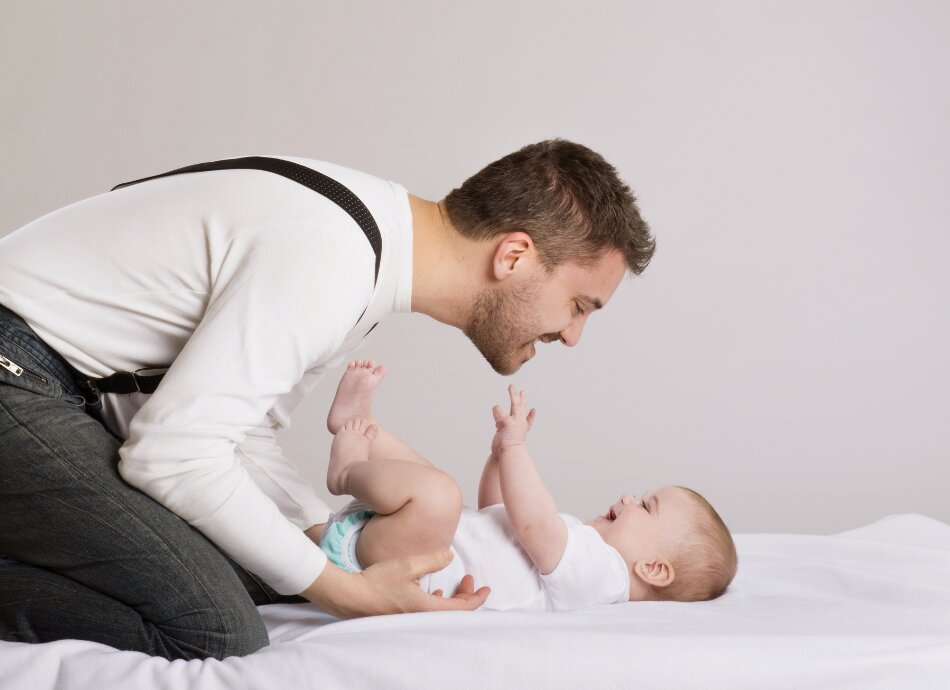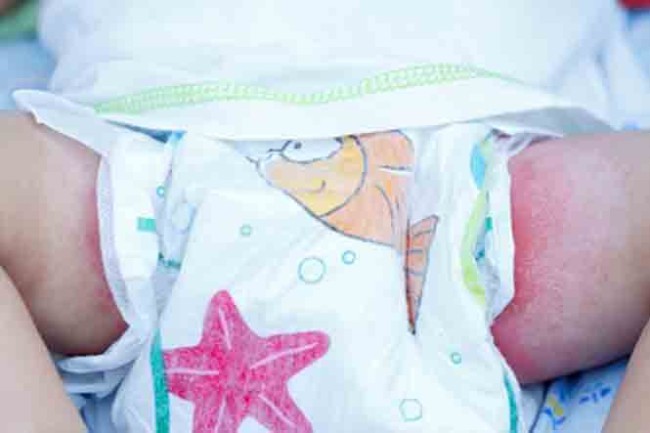Nappy rash
Key points about nappy rash
- Nappy rash is caused by wetness, irritation or infection, or a combination of these.
- Most nappy rash can be prevented. Change nappies as soon as possible after they become wet or dirty, dry carefully before putting the new nappy on, use a barrier cream or ointment, avoid irritants and give your baby nappy-free time.
- Usually the rash is mild and doesn't bother your pēpi, but it can be sore.
- If the rash gets worse or infected, or your baby gets a fever, see your healthcare provider, pharmacist or wellchild nurse.
- They may suggest a mild steroid ointment or an antifungal cream.

Nappy rash is a very common rash in the nappy area which happens when the skin on your baby’s bottom is damaged or irritated. The main cause of nappy rash is wearing a wet or dirty nappy for too long.
Nappy rash is usually mild, but your baby's bottom may look red and raw, and can also be spotty – particularly at the edge of the rash. It can be sore or itchy when the area is wiped and your baby may be unsettled or irritable because of it.
The main cause of nappy rash is wearing a wet or dirty nappy for too long.
Wetness and rubbing
Constant wetness and rubbing can damage your baby's skin. The longer a nappy is wet or dirty, the more likely there will be damage to their skin. This is because there's material in pee and poo which irritates skin.
Irritation
The rash can be made worse by other things that irritate the skin.
- Watery loose poo
- Acidic foods, eg, orange juice
- Detergents and soaking solutions used for cloth nappies
- Some baby wipes and soap can cause dry skin.
Infection
Yeast (candida or thrush) thrives in warm moist places. It’s often present when there’s a severe nappy rash. It can be treated with an antifungal cream.
Bacterial infections can also happen where there's broken skin and can be treated with antibiotic medicines.
Using antibiotics
Antibiotics given for other infections can add to nappy rash by killing bacteria that usually keep yeast growth under control. Antibiotic use can also cause diarrhoea which can irritate your baby’s skin.
Breastfed babies whose mothers are taking antibiotic medicines are also at increased risk of nappy rash.
Introducing new foods
Nappy rash is more likely when your baby starts eating solid foods because the content of their poo changes. Changes in your baby’s diet can also increase the number of poos they do each day which can also cause nappy rash.
Breastfed babies may get nappy rash if their poo changes in response to something the mother has eaten.

Image credit: Depositphotos
Nappy rash can start or get worse when your baby is teething.
It's unclear why teething can lead to nappy rash, but it's thought it could be because your baby produces more saliva. This changes their poo, making it more likely to cause a reaction when it touches their skin.
Nappy rash can be treated and prevented by doing a few simple but important things to protect their sensitive skin.
Nappy changing
- Change your baby's wet or dirty nappy as soon as possible. This can be 5 to 7 times a day for babies under 12 months old.
- Use a warm wet cloth for washing baby’s bottom.
- If there is poo use a soap and fragrance-free cleanser. Wash the area gently. Too much cleaning can irritate the skin.
- Make sure your baby's bottom is properly dry. Dry by patting, not by rubbing, with a towel.
- Put on a barrier cream or ointment, then a clean nappy.
Avoid the following as they can cause skin irritation:
- Baby wipes. If you need to use baby wipes while you’re away from home choose brands with no fragrance that are designed for sensitive skin
- Soaps, bubble bath and lotions
- Plastic pants
- Talcum powder.
Barrier creams and ointments
Barrier creams (often called nappy creams) or ointments help to protect your baby’s skin from moisture. They make a barrier between your baby's skin and the poo or pee.
Apply a barrier cream thickly around your baby’s anus, and penis or vulva at each nappy change. You don’t need to clean away all of the barrier cream from last time if the nappy is only wet.
Examples of barrier creams or ointments are:
- zinc and castor oil ointment
- white soft paraffin ointment
- Bepanthen® ointment
- Sudocrem®.
Barrier creams can be bought at the pharmacy or supermarket.
Nappies
If you’re using disposable nappies, choose the best quality brand you can afford, one that absorbs moisture quickly.
If you’re using cloth nappies:
- rinse dirty nappies immediately in cold water before washing
- wash the nappies in a hot wash in the washing machine
- use gentle washing powders
- rinse the nappies twice to remove soap residue.
Drying nappies in the sun doesn't remove germs or sanitise them as the UVC rays needed to do this are blocked by ozone in the earth's atmosphere. Read more about how to sanitise cloth nappies.(external link)
Have some nappy-free time
Give your baby as much time as possible with their nappy off each day.
Exposing your baby’s bottom to air is a good gentle way to let it dry after cleaning it. You can lay your bare-bottomed baby on a towel for a while before putting on a fresh nappy.
When to get help
Most nappy rash gets better with these simple measures. If the rash doesn't start to get better within a few days, your baby may need other treatment, eg, for a skin condition such as thrush.
See your healthcare provider, pharmacist or Plunket nurse if any of the following happen:
- the rash doesn't clear up with the treatment described above or it gets worse
- your baby is irritable (upset) or seems to be extremely uncomfortable
- the rash seems infected – a bright red, moist rash with white or red pimples, which spreads into the folds of the skin (this could be a yeast infection)
- your baby develops a fever (high temperature).
If you want some advice about your baby's nappy rash, call Plunketline (0800 933 922).
If your baby's nappy rash doesn’t improve with the treatment above, your healthcare provider may suggest:
A mild steroid cream or ointment, eg, hydrocortisone. Available from your pharmacy.
Steroids reduce the redness and inflammation. Only use a very small amount as prescribed. The steroid cream goes on before the barrier cream or ointment. Steroid cream or ointment should only be needed for a few days, and no longer than a week.
An antifungal cream that kills thrush (candida.) Available from your pharmacy.
This is usually applied 2 to 3 times a day. All of the barrier cream or ointment from the last nappy change needs to be cleaned off first so that the antifungal is touching your baby’s skin, then put a new layer of barrier cream on over the top. Unlike a steroid cream, continue to use an antifungal cream for 7 to 10 days after the rash has cleared, to make sure all the yeast has gone.
An antibiotic medicine. Available from your doctor or nurse practitioner only.
Occasionally, broken skin from nappy rash can become infected with bacteria. This type of infection is treated with an antibiotic medicine taken by mouth. You will need to keep putting cream or ointment on the rash as well.
Nappy rash(external link) KidsHealth, NZ
Nappies and nappy rash(external link) Plunket, NZ
Nappy rash(external link) Sydney Children’s Hospitals Network, Australia
Apps
Brochure
What is diaper rash?(external link) The Society for Pediatric Dermatology, US
References
- What is diaper rash?(external link) The Society for Pediatric Dermatology, US, 2018
- Using sunlight (ultraviolet light) for stain removal and sanitisation(external link) Clean Cloth Nappies, Australia NZ
- Nappy rash fact sheet(external link) Sydney Children’s Hospitals Network, Australia, 2024
- Nappy rash(external link) KidsHealth, NZ
- Diaper (nappy) rash(external link) Mayo Clinic, US, 2012
Clinical practice guidelines(external link) Nappy rash The Royal Children's Hospital Melbourne, Australia
Nappy dermatitis(external link) Starship, NZ, 2019
Credits: Healthify editorial team. Healthify is brought to you by Health Navigator Charitable Trust.
Reviewed by: Dr Emma Dunning, Clinical Editor and Advisor
Last reviewed:





